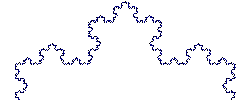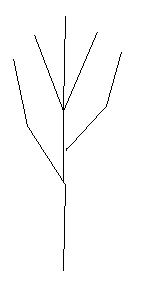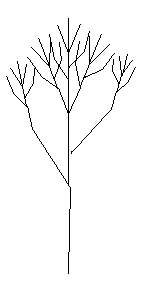
|
UMBC CMSC 201 Fall '06 CSEE | 201 | 201 F'06 | lectures | news | help |
A fractal is a geometric object which can be divided into parts, each of which is similar to the original object.
A Koch snowflake is a simple example.
It's the result of infinite additions of triangles to the perimeter of a starting triangle.
Each time new triangles are added (an iteration), the perimeter grows, and eventually approaches infinity.
In this way, the fractal encloses a finite area within an infinite perimeter.
A complex fractal shape emerges from the simple repetition of a basic shape at a smaller and smaller scale.
When you zoom in to a fractal, at every scale it appears the same.
If you "zoom in" on the infinite version of a Koch curve, you see more and more detail, but it all looks the same.
Here's an animation:

Self-similarity makes fractals useful for modeling natural systems.
Consider the shape of a tree. From the trunk of a tree shoot off several branches.
Each branch then repeats this branching pattern and gives rise to smaller branches.
So the tree branching is self-similar.
 |
 |
 |
some material adapted from MathBlues